Site Closure Achieved at Colorado Service Station
Benzene Levels Reduced to Below 5 PPB in Clay Soils through Use of ORC® Advanced
Project Highlights
- Benzene concentrations remained on-site despite previous excavation efforts.
- Enhanced aerobic biodegradation using ORC Advanced produced a 99.8% reduction over 12 months.
- Benzene reduced to below detection limits.
- “No Further Action” letter granted in October 2010.
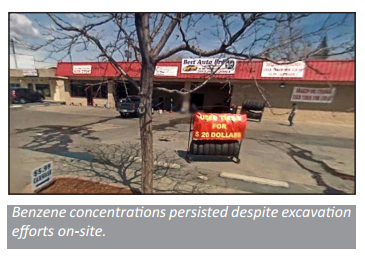
Project Summary
Three underground storage tanks (USTs) were removed at a former tire store as part of corrective measures. Roughly 108 cubic yards of soils were excavated to reduce contamination levels. However, the excavation did not extend below the groundwater interface and residual sorbed contaminant mass remained, resulting in a lingering benzene plume. The client was interested in an in situ approach to reduce the remaining benzene contamination to below the Tier 1 risk based screening level of 5 ppb.
Remediation Approach
A direct-push injection of Oxygen Release Compound Advanced (ORC® Advanced) was chosen to reduce remaining soil and groundwater contamination at the location of the former excavation and well BW-1. Maximum TVPH and benzene concentrations in the prior two years were as high as 2.4 mg/L and 0.48 mg/L, respectively. Due to tighter soils, a 7-footon-center grid pattern with 15 injection points was implemented on-site. ORC Advanced was injected from approximately 6 to 13 feet below ground surface with about 1 foot of the injection interval extending above groundwater in the event of rising water levels. A total of 725 pounds of ORC Advanced was injected for this project.
Despite the relatively tight soils and high potential for contaminant back diffusion, the ORC Advanced treatment resulted in consistent downward trends of benzene contamination. A 96.3% reduction in benzene after only 3 months was observed. By month 12, a 99.8% reduction to below detection limits (The site was granted a no further action letter.)
Technology Description
ORC Advanced® is a proprietary formulation of food-grade, calcium oxy-hydroxide that produces a controlled-release of molecular oxygen for periods of up to 12 months upon hydration.
RegenOx® Injected Into Frozen Permafrost at Alaska Site
Seasonal Access and Remote Location Require Unique Remediation Plan at Service Station
Project Highlights
- Sensitive ecosystem and limited seasonal accessibility required a unique remediation plan design.
- RegenOx® injected into frozen permafrost.
- Overall remediation plan requires three applications while site is accessible in summer months.
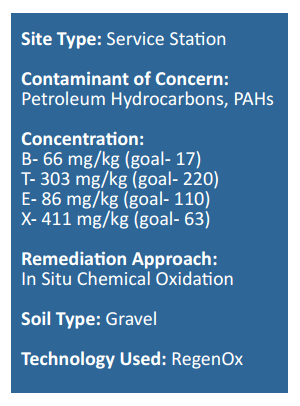
Project Summary
Located in Deadhorse, Alaska, this service station site was contaminated through multiple releases from the diesel and gasoline tanks. When this lease site was originally bid, it was required to be constructed with a minimum of 5 feet of gravel on the pads to protect the tundra. This lease requirement remains today.
The remote location on the North Slope of Alaska made it challenging to design, plan, and implement a remediation plan considering the temperatures were just above freezing. The area can only be accessed seasonally for monitoring/application and shipping products to the site proved to be a challenge. Located in a very sensitive native ecosystem (tundra/permafrost), in situ chemical oxidation (ISCO) was chosen as the remediation approach to avoid enlarging the plume.
Overall treatment goal for the project is to reduce hydrocarbon concentrations in approximately 365 cubic yards of source area soil to below cleanup levels. Treatment will be conducted in multiple phases and this project summary will summarize steps taken within the first year to address one-third of the exceedance area.
Remediation Approach
Surface soil to down to one-foot below ground surface was removed and stockpiled before subsurface soil from (1-5 feet below ground surface) was treated via in situ soil mixing using RegenOx®. Based on the effectiveness of Year 1 treatment; the plan is to use the same treatment method on remaining soil in subsequent years.
For the 125 cubic yards (or 1/3 of contaminated soil at the site), a total of 3,430 pounds of RegenOx (2,500 pounds of RegenOx Part A and 930 pounds of RegenOx Part B) were applied to treat BTEX, TPH, and naphthalene concentrations. Due to the sensitive and remote nature of the site, the application was staggered and the methodology was ultimately modified to prevent oversaturation and reduce the risk of plume migration. The Part B was mixed with a small amount of water and then applied and mechanically mixed thoroughly into the treatment area, followed by the Part A being applied dry and then well-mixed over the same area.
Technology Description
RegenOx is an advanced chemical oxidation technology that destroys contaminants through powerful, yet controlled chemical reactions and not through biological means. This product maximizes in situ performance while using a solid alkaline oxidant that employs a sodium percarbonate complex with a multi-part catalytic formula.
REGENESIS Remediation Services – LNAPL Treated with Combined Remedies
Active Michigan Service Stated Remediated Through Use of PetroCleanze® and ORC® Advanced
RRS was contracted to remediate a residual LNAPL and dissolved phase petroleum plume from historic gasoline and diesel fuel releases at an active service station. PetroCleanze® was chosen as the primary remediation technology to facilitate recovery of residual LNAPL and chemically oxidize contaminants without negatively impacting sensitive infrastructure. ORC® Advanced was also applied with the final PetroCleanze application event and in a downgradient plume cut off barrier to promote the enhanced aerobic bioremediation of the dissolved-phase petroleum hydrocarbons.
Eight injection/extraction wells and 28 direct-push injection points were used to apply the remediation reagents in the silty sand aquifer and smear zone over three application/injection events. Vacuum extraction was conducted between PetroCleanze applications to recover residual free phase petroleum hydrocarbons liberated from the soils. Reagent distribution monitoring confirmed PetroCleanze was dispersed across the targeted source area during each application event.
Prior to the first PetroCleanze application event, no measurable free product was observed on this site since 2006. Less than twenty-four hours after the first PetroCleanze application event, LNAPL was observed in four of the eight wells in the source area at quantities up to three inches thick.
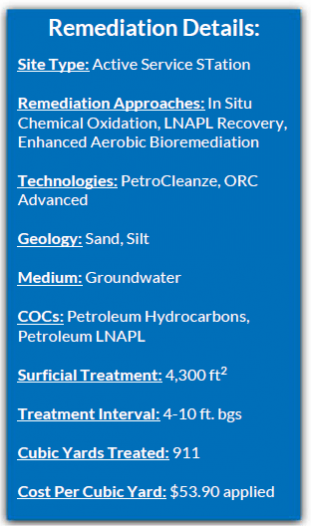
Not more than a sheen was observed in any wells on site after the third injection event. A total of 2,160 pounds of PetroCleanze and 1,120 pounds of ORC Advanced were injected.
Regenesis Remediation Services™ – LNAPL Plume Treated at Iowa Service Station
PetroCleanze and ORC Advanced Remediate Historic Petroleum Hydrocarbon Contamination
RRS was contracted to remediate a dissolved phase LNAPL petroleum hydrocarbon plume petroleum fuel releases at a former service station PetroCleanze® was chosen as the primary remediation technology to facilitate recovery of residual LNAPL and chemically oxidize contaminants without negatively impacting sensitive infrastructure. ORC Advanced was also applied with the final PetroCleanze application enhanced aerobic bioremediation of hydrocarbons.
Eighteen direct-push injection points were used to apply the reagents in the silty sand aquifer and application events. Three vacuum extraction conducted after each PetroCleanze application to recover residual free phase petroleum hydrocarbons liberated from the soils.
Reagent distribution monitoring confirmed PetroCleanze was dispersed across the targeted source area during events.
Direct-push injection points were advanced to 15 feet below ground surface where bottom-up injections were performed to 5 feet. A total of 4,470 pounds of PetroCleanze and 720 pounds were injected.
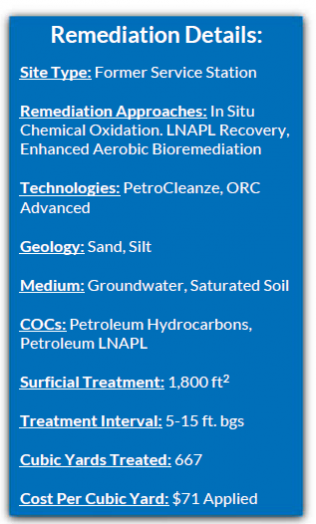
ORC Advanced® Treats Multiple Plumes and High TPH Concentrations
CASE SUMMARY
Past operations at a former U.S. Navy Base in American Samoa had resulted in total petroleum hydrocarbon (TPH) contamination within the subsurface. Currently occupied by an elementary school, the former military base once stored barrels of petroleum-based fuels for military operations. A hydrocarbon sheen was evident following rain events prompting the need for a remedial investigation to determine the extent of contamination within the subsurface. Soil boring samples revealed elevated levels of TPH-diesel, TPH-gasoline, and TPH-motor oil at concentrations exceeding the cleanup standard. Site investigations did not identify any TPH impact to groundwater.
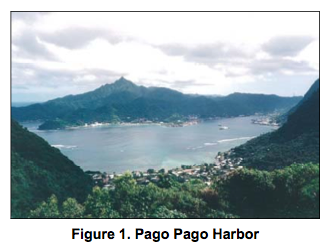
Access to the site and equipment was very limited thus on-site sampling and remediation was conducted only annually when the school was out of session. As a result, a remedial approach was required in which no operations & maintenance would be necessary. In addition, a technology was needed which would not damage on-site structures, successfully treat low permeable soils, and not disrupt the day to day operations of the elementary school. Enhanced bioremediation using ORC Advanced® was chosen since it did not require on-site maintenance and would effectively treat TPH concentrations within a reasonable timeframe.
REMEDIATION APPROACH
The initial application of ORC Advanced® was applied in 2005 via multiple trenches to address the three identified plumes (Figure 4). ORC Advanced® was mixed with water to form a slurry then placed at the bottom of each trench prior to backfilling (Figure 3). Soil sampling one year later indicated a reduction in TPH levels; however three boring samples remained above the cleanup goal. This was explained by the lack of water available in the subsurface to move the ORC Advanced® radially from the applied trench area. A second application in 2006 was delivered via direct-push injection using approximately 2,000 pounds of ORC Advanced® into a total of 82 injection points (Figure 5 & 6). In 2007, an ORC Advanced® injection application was completed to treat the few remaining hot spots. One last application is scheduled for summer 2008.
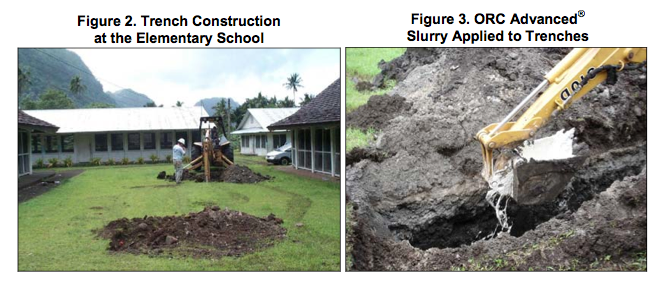
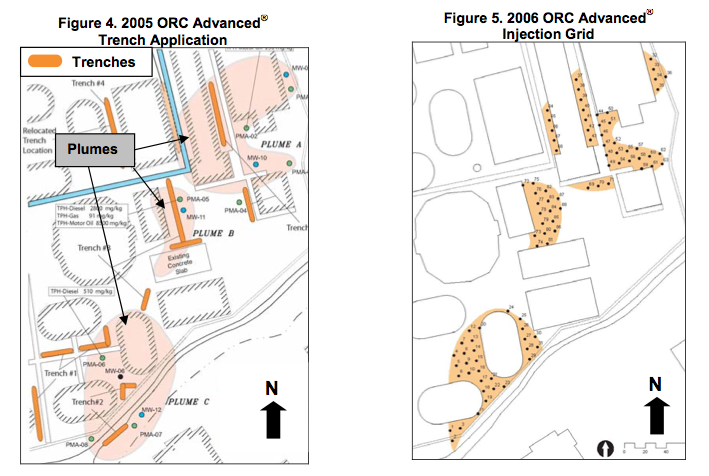
RESULTS
Trench Application
The 2005 trench application was successful in reducing TPH concentrations significantly (Table 1). Within the area of highest concentrations (PMA-05), TPH-diesel was reduced from 2,800 milligrams per kilogram (mg/kg) to 1,700 mg/kg, TPH-motor oil declined by 50% and TPH-gasoline was reduced to below the cleanup goal of 50 mg/kg. Of the eight sampled areas, three remained above the Project Action Level – PMA-01, PMA-02, and PMA-05. Although the trench application was successful in reducing concentrations within the immediate application area, the radius of influence was not great enough to remediate the entire plume. Therefore, a follow up application was designed using direct-push technology.
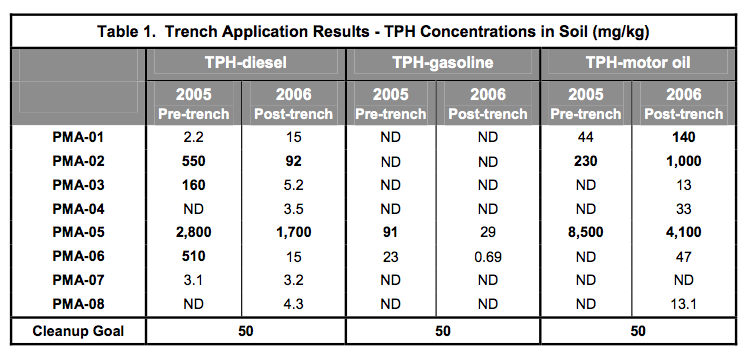
Direct-Push Application
The direct-push application substantially reduced high concentrations of TPH-diesel and TPH-motor oil (Table 2). Most significant was area PMA-05 where TPH-diesel declined from 1,700 mg/kg to below the cleanup goal and TPH-motor oil was reduced from 4,100 to 120 mg/kg, a 97% reduction. An increase in concentrations was observed as a result of the direct-push technique which mobilized residual contamination from the soil. A direct-push injection was completed in July 2007 to address the remaining concentrations of TPH-diesel and TPH-motor oil. A total of 2,500 pounds of ORC Advanced® were applied using the same design layout as the 2006 application (Figure 5). One last application is planned for summer 2008.

CONCLUSION
To date, one ORC Advanced® trench application and two direct-push injections have been completed. The trench technique was effective within the immediate vicinity of the application. However, in order to achieve a better radius of influence, the direct-push technique was more effective. Additionally, the impact and inconvenience to the site from direct-push was significantly less in comparison to the large trenched areas as shown in Figures 2 and 3.
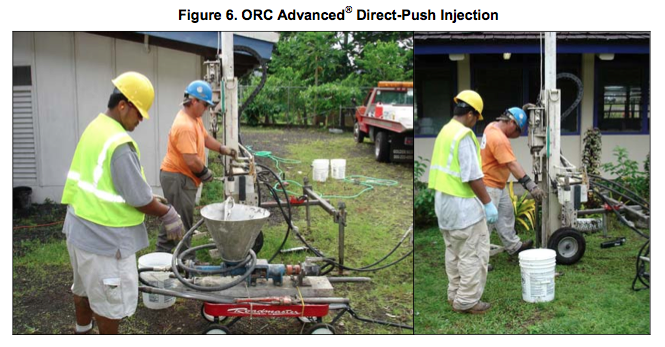
TPH-motor oil has remained above the cleanup goal as seen in Table 2. This can be explained by the fact that the molecular size of motor oil is more significant compared to diesel and gasoline and, therefore, more time is needed to breakdown the molecule. In addition, as a result of the injection, mobilization of residual contamination from the soil caused an increase in concentrations. The July 2007 application is expected to continue the breakdown of any remaining contamination, including motor oil, towards the cleanup goal. Sampling will again be completed in the summer of 2008 along with one final ORC Advanced® application.
Combined RegenOxTM and ORC Advanced® Application Treats TPH and BTEX
Introduction
Operations at a former car dealership resulted in petroleum hydrocarbon contaminated soil and groundwater. In the source well SB7, groundwater concentrations of total petroleum hydrocarbons (TPH) had increased to 250 parts per million (ppm) and concentrations of benzene, toluene, ethylbenzene, and xylenes (BTEX) were present at more than 400 ppm. In order to reach the TPH site specific target level (SSTL) of 19.2 ppm, a combined remedial approach using chemical oxidation and enhanced aerobic bioremediation was implemented. Injections of RegenOxTM and ORC Advanced® were applied in four separate injection events (Table 1). The combined approach was designed to treat the high concentrations and promote aerobic bioremediation of any remaining residual contamination.
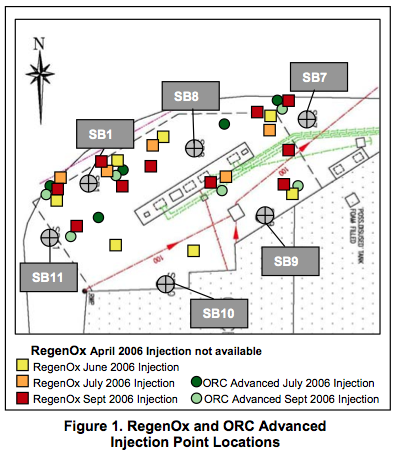
Remediation Approach
The remedial objective was to reduce high concentrations of TPH to below the SSTL of 19.2 ppm. RegenOx was applied in April 2006 and June 2006 across the plume (Figure 1). Both RegenOx and ORC Advanced were applied separately in July 2006 and September 2006. (Table 1)

In Situ Treatment Results
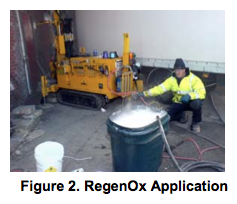 Shortly after the initial RegenOx chemical oxidation treatment, TPH was reduced by an average of 67% (Graph 1). As is typical following the first chemical oxidation application, contaminant rebound occurred after approximately one month. This is primarily a result of rapid desorption of sorbed phase contaminants from soil into groundwater and the 30 day longevity of RegenOx. Three follow up RegenOx injections were applied to continue treatment and eliminate the remaining contamination. Additionally, two ORC Advanced injections were performed to provide a long-term (12 months on average) oxygen source for enhanced aerobic bioremediation.
Shortly after the initial RegenOx chemical oxidation treatment, TPH was reduced by an average of 67% (Graph 1). As is typical following the first chemical oxidation application, contaminant rebound occurred after approximately one month. This is primarily a result of rapid desorption of sorbed phase contaminants from soil into groundwater and the 30 day longevity of RegenOx. Three follow up RegenOx injections were applied to continue treatment and eliminate the remaining contamination. Additionally, two ORC Advanced injections were performed to provide a long-term (12 months on average) oxygen source for enhanced aerobic bioremediation.
RegenOx was effective at reducing TPH to below the SSTL in all wells, excluding SB7 (Graph 1) which was located within the source area. However, a reduction of 95% occurred in SB7 within two weeks of the initial RegenOx injection. Rebound was observed in this area throughout the treatment, indicating that sorbed phase TPH was more prevalent around this well. RegenOx reduced the overall TPH loading of the soils and maintained TPH concentrations in groundwater to below 60 ppm. The ORC Advanced applications are expected to further TPH reduction in this area via enhanced aerobic biostimulation beyond the length of the monitoring program.
Conclusion
As a result of the RegenOx applications, concentrations were reduced quickly and cost-effectively within weeks of the injections. It is expected that the remaining concentrations above the SSTL in Graph 1 will be reduced as ORC Advanced continues to release oxygen. Successful closure was achieved due to the overall reduction in TPH concentrations, the observed reduction in contaminant concentrations in the source area, and the expected future reductions from the application of ORC Advanced.
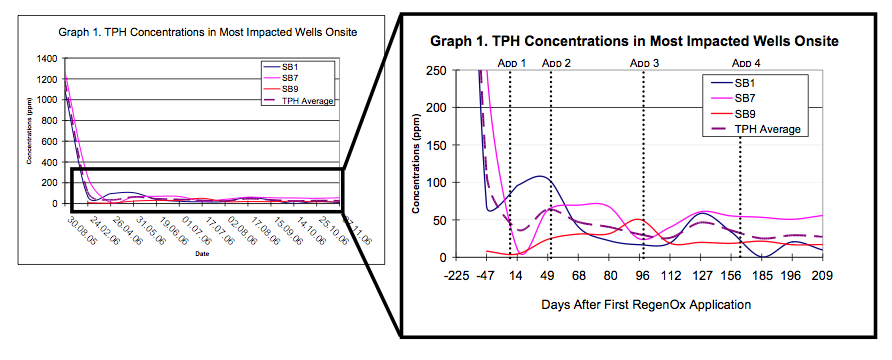
RegenOx® Treats Benzene in Low Permeability Soils
Introduction
Service station operations created a benzene contaminant plume in tight subsurface soils. A dual-phase extraction system (DPE) was installed and removed a total of 9,965 pounds of petroleum hydrocarbons over two 90-day operational periods. However, contaminant removal reached asymptotic levels and a more effective remedial strategy was needed to address the remaining benzene concentrations. The DPE system was shut down in December 2004 and RegenOx® was selected to evaluate the effectiveness of reducing benzene and MTBE concentrations in tight soil lithology.
Description of Activities
RegenOx was pilot tested around well DPRW-6 to evaluate its effectiveness in tight soil. A total of 1,439 pounds of RegenOx was applied near well DPRW-6 as a pilot test in August 2005 (510 lbs) and July 2006 (929 lbs). Benzene concentrations declined within 15 weeks by 76% and successfully reached the Site Specific Target Level (SSTL) (Graph 1), prompting a design for full scale implementation.
The objective of full-scale treatment was to provide rapid mass reduction of benzene concentrations and reach the SSTL of 20.1ppm across the 9,100 ft2 source area. Benzene rebound at DPRW-6 (the original pilot test well) six months post-injection suggested that a previously unidentified plume had re- contaminated that area. After additional site characterization was completed, 7,110 pounds of RegenOx were applied during six injection events over five treatment areas (Figure 1).
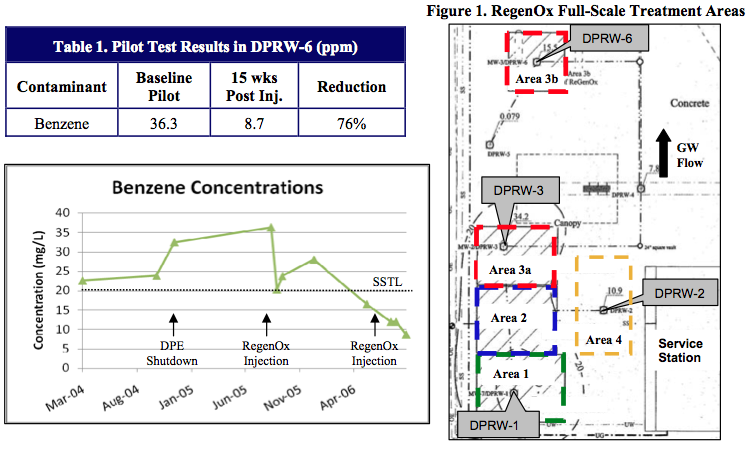

The RegenOx injections were performed over a 6 month period due to weather delays. Monitoring was conducted to observe potential contaminant rebound from areas requiring additional injections. The applications targeted a treatment thickness of 14-20 feet bgs into silty clay with intermittent sand “stringers”. RegenOx was injected using a top-down direct-push injection technique with 5-15 lbs of RegenOx injected per vertical foot.
Results
Prior to the full-scale application, benzene concentrations exceeded the SSTL of 20.1ppm in all wells. Monitoring over a 7 month period prior to remedial treatment indicated an increase in concentrations from 12 – 32ppm to 20.4 – 44.1ppm.
RegenOx was applied over six injection events as indicated in Table 2. Sampling conducted
after the final application event in December 2007 indicated a benzene reduction to at or below the SSTL in all wells (Graphs 2) including the original pilot test well DPRW-6. As monitoring continued, a decline in benzene concentrations persisted via natural attenuation and all wells sampled below 10ppm in August 2009. Based on the reducing trend observed over the past 12 months, the site was recommended for closure.
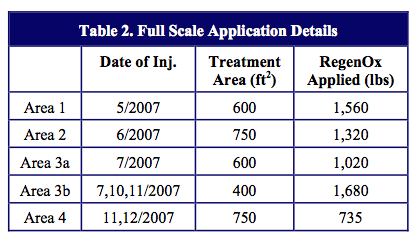
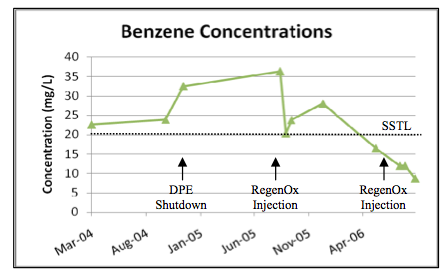
DOD Treatability Study Documents Successful Carbon Tetrachloride Remediation using HRC®
Contaminant Concentrations Reduced by 99% Within One Year
Project Highlights
- Treatability study demonstrated effective reduction of carbon tetrachloride and benzene contamination
- Combined application of HRC® and HRC Primer® reduced carbon tetrachloride concentrations to below cleanup goal within one year
- Influx of additional carbon tetrachloride contamination to the site was buffered by enhanced anaerobic bioremediation
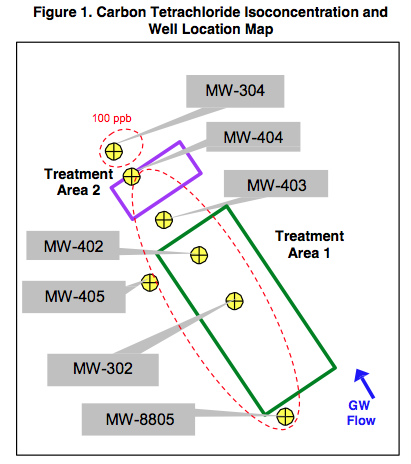
Project Summary
Historic operations at a Department of Defense site in Maryland resulted in soil and groundwater contamination with carbon tetrachloride, benzene, and chloroform at concentrations of 274 μg/L, 178 μg/L, and 21 μg/L, respectively. Monitoring at the site revealed decreasing trends in contaminant concentrations as a result of natural attenuation. However, the site was on a redevelopment schedule and monitored natural attenuation was deemed to be too slow and costly.
The Air Force, in conjunction with the Comprehensive Environmental Response, Compensation, and Liability (CERCLA) Partnering Team, agreed to perform a treatability study to observe the effectiveness of enhanced anaerobic bioremediation to reduce the contaminants. A focus was placed on the biodegradation of carbon tetrachloride due to its highly recalcitrant nature; if it could be treated, so could the other constituents, such as benzene1. Although benzene is commonly degraded under aerobic conditions, the destruction of the contaminant has also been known to occur under anaerobic conditions.1
A mixture of HRC and HRC Primer was applied to the contaminated site to establish optimal reducing conditions in groundwater and thereby enhance the process of reductive dechlorination. Direct-push injections were applied in a grid pattern within the two treatment areas shown in Figure 1. Groundwater monitoring was conducted in and around the treatment areas to evaluate the distribution and treatment effectiveness.
Technology Description
HRC is an engineered, hydrogen release compound designed specifically for enhanced, in situ anaerobic bioremediation of chlorinated compounds in groundwater or highly saturated soils.
HRC Primer is derivative of the standard Hydrogen Release Compound (HRC) product and is designed to provide a controlled but fast release of hydrogen to assist in initiating anaerobic biodegradation.
Results
Carbon Tetrachloride Reduced up to 99% After 3 Months
Sampling results three months after the HRC/HRC Primer injection revealed carbon tetrachloride reductions of 87% – 99% within the treatment areas. Downgradient wells MW-403 and MW-304 were also affected by HRC, with carbon tetrachloride concentrations declining below the maximum contaminant level (MCL) of 5 μg/L. Continued reductions in the HRC-affected wells were observed over the following year, with levels dropping below the cleanup goal in 5 of the 6 wells. (Graph 1).
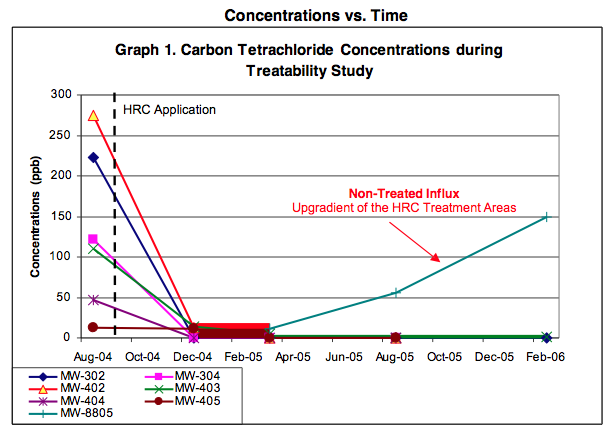
During the same sampling period, a continuous increase in the concentration of carbon tetrachloride was observed in well MW-8805 upgradient of the treatment areas. This increase is indicative of an influx of additional contamination to the area, which is assumed to have also occurred within the nearby treatment areas. Importantly, the contaminant levels within the HRC-affected wells remained below 5 μg/L during this period, indicating the effective treatment of both resident and influx carbon tetrachloride.
Benzene Concentrations Declined Up To 98%
Baseline benzene concentrations exceeded 150 μg/L prior to the treatability study. Reducing conditions were established shortly after the HRC/HRC Primer injection, and concentrations declined 56% – 98% over the following 18 months. Concentrations are expected to reach the cleanup goal of 5 μg/L as HRC continues to be effective in the subsurface.
Chloroform Concentrations Reduced to Cleanup Standards
Initial chloroform concentrations were above 20 μg/L. Six months post-HRC application, 3 out of the 6 HRC-treated wells sampled below the MCL of 0.15 μg/L. Within 12 months, the cleanup goal was reached in all wells except MW-403 (2.3 μg/L).
1 In the presence of certain microbes, Dechloromonas strain RCB and strain JJ, Benzene can be degraded anaerobically (Coates, J. D., Chakraborty, R., Lack, J. G., O’Connor, S. M., Cole, K. A., Bender, K. S., Achenback, L. A. “Anaerobic Benzene Oxidation Coupled to Nitrate Reduction in Pure Culture by Two Strains of Dechloromonas.” Nature June 28, 2001: 1039-1043.)
Rapid Reduction of Petroleum Hydrocarbons using ORC Advanced® allows for Redevelopment of Site
Summary
Remedial works at the Former Lama Petroleum site were undertaken in late 2008 as part of the ongoing redevelopment of the Fresh Wharf Estate in Barking UK. The site was to be developed for light industrial use, however, historical oil mixing handling and storage activities performed on the site had resulted in TPH and PAH contamination in the groundwater.
Site investigation works suggested the presence of an approximately 1,000m2 source area in thenorthwestern portion of the site, as well as a downgradient plume area, estimated to be in the region of 6,000m2 extending towards the Handtrough Creek. Phase separated hydrocarbons were detected in the source area where the former above ground storage tanks had been located prior to decommissioning circa 2003. In the downgradient plume area, the maximum dissolved phase TPH concentration was 1,100μg/L (Monitoring Well BH102) and located adjacent to Handtrough Creek.
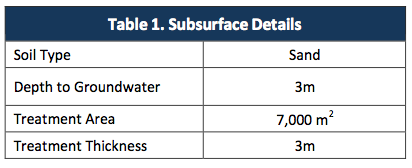
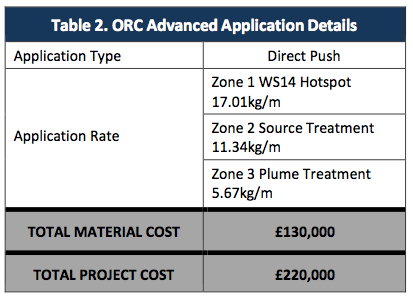
Remedial Strategy
The remedial objective was to reduce dissolved phase concentrations of Total TPH and PAH in groundwater to the agreed remedial target level of 110μg/L, within 12 months of treatment. A trigger level for further remediation was set at 200μg/L, equating to an 80% contaminant concentration reduction within 42 weeks post treatment. If the trigger TPH concentration was not achieved within 42 weeks after treatment, further options would be undertaken.
The original assessment of remedial options identified that a combination of Pump and Treat (P&T) to target free product in the source area and ORC Advanced® treatment in the groundwater plume would represent the most time‐efficient and cost‐effective remedial solution for the site. However, trial pits advanced in the source area during site clearance works
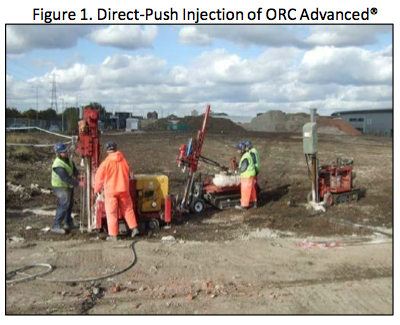
determined that free product was not present in the groundwater, but was present in discrete bands within the unsaturated made ground. Following this observation, excavation to remove the most impacted soils in the source area was determined to be the most suitable approach and P&T was discarded as an option.
Soil removal works were undertaken at the site in October 2008. ORC Advanced treatment in both the source and plume areas was undertaken in October and November 2008. ORC Advanced was applied using three direct push injection rigs and a separate mixing and pumping unit. The rods were driven to 6mBGL and the ORC Advanced was applied over the impacted saturated zone as the rods were slowly withdrawn to 3mBGL. The application included a total of 813 injection points over 19 drilling days. The dose rates were varied to match the different contaminant concentrations and conditions encountered across the site (Tables 1 & 2). Vibro‐piling works were completed across the site at the same time as the ORC Advanced was being applied and were unimpeded by the direct push equipment.
Results
Following the injection of ORC Advanced, a slight increase in the dissolved phase contaminant concentrations was observed due to the site disturbance from injection and piling works. Both TPH and PAH concentrations then rapidly decreased to below the site specific remedial target values and remained low over the monitoring programme. A 99% reduction in the groundwater concentrations of TPH and PAH was achieved with no rebound. Monitoring results are presented below for well BH102, which was located on the southern site boundary, adjacent to Handtrough Creek.

Conclusion
Following the application of ORC Advanced, TPH and PAH concentrations were rapidly reduced and maintained below the site specific target values without contaminant rebound. The works were completed safely and efficiently and did not hinder the ongoing construction works occurring simultaneously at the site. The low final contaminant concentrations and the lack of rebound resulted in regulatory acceptance of the remediation and development works were completed.
London Olympic Park Environmental Cleanup Uses Bioremediation Technology ORC Advanced® to Treat Hydrocarbons and Expedite Construction

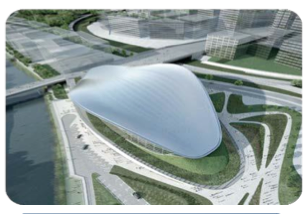
The multi-billion dollar development of the 500 acre London 2012 Olympic Games Park has been one of the largest Brownfields regeneration projects in recent years. Located in Stratford in East London, the site was formerly an industrial estate with uses including: chemical, fertilizer, engineering works, landfills and depots leaving a legacy of soil and groundwater contamination.
The Olympic Delivery Authority (ODA) set strict deadlines for the Olympic facility construction projects. The development included the construction and refurbishment of 16 new major stadia and sports facilities. More specifically, the subsurface foundations for the London Aquatic Centre (LAC) were to be completed by the 27th July 2009 (exactly three years before the London 2012 Olympic Games Opening Ceremony).
The LAC site was contaminated with petroleum hydrocarbons from lubricating oil as a result of historic operations. The first stage of remediation began in November 2007 using dual-phase vacuum extraction (DPVE) to remove the LNAPL, however due to the strict ODA deadlines and integration with construction programmes (starting in April 2008) prolonged use of DPVE was not practical to remediate the dissolved phase hydrocarbon plume. An in situ
solution became the only viable option.
In Situ Enhanced Bioremediation, a widely accepted and well understood natural biodegradation process was chosen to cleanup this portion of the site. This approach
utilizes indigenous microbes to aerobically biodegrade petroleum hydrocarbons in-place. The actual process is facilitated using an injectable, Advanced Oxygen Release Compound (ORC Advanced®). Upon hydration and injection, this powder-like material accelerates aerobic bioremediation by releasing molecular dissolved oxygen for periods up to 12 months on a single application. Without this valuable oxygen supply, the required aerobic bioremediation processes either cease or proceed at very slow rates
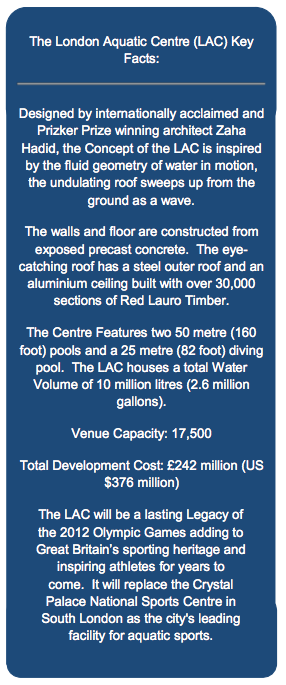
The patented Controlled-Release Technology (CRTTM) in ORC Advanced allows for an efficient, long-term release of oxygen which provides optimal conditions for sustained aerobic biodegradation. CRT also saves time and money during implementation by eliminating the need for multiple oxygen release compound applications.
Additionally, ORC Advanced® was applied at the LAC site using direct-push injection. This application approach is highly efficient as it requires no permanent well installation, above-ground piping or mechanical equipment and after application, no operational costs or further site disturbance. Remedial objectives or the Olympic Games Aquatic Centre were satisfied and redevelopment of the site was unhindered by the ongoing in situ remedial work. More importantly, the construction-phase was completed according to the ODA set deadlines.
REGENESIS is proud to have supported environmental consultants, remediation contractors and regulators in successfully delivering the multi-billion dollar, award winning, remediation for The London 2012 Olympic Games.

 Americas
Americas Europe
Europe Français
Français Deutsch
Deutsch Italiano
Italiano Español
Español





